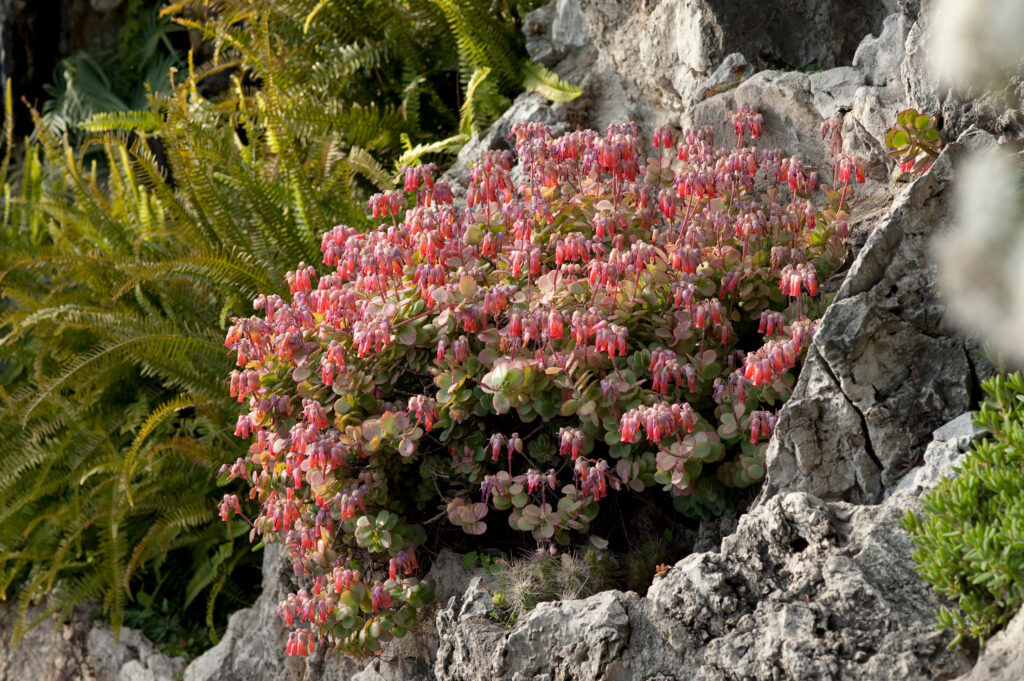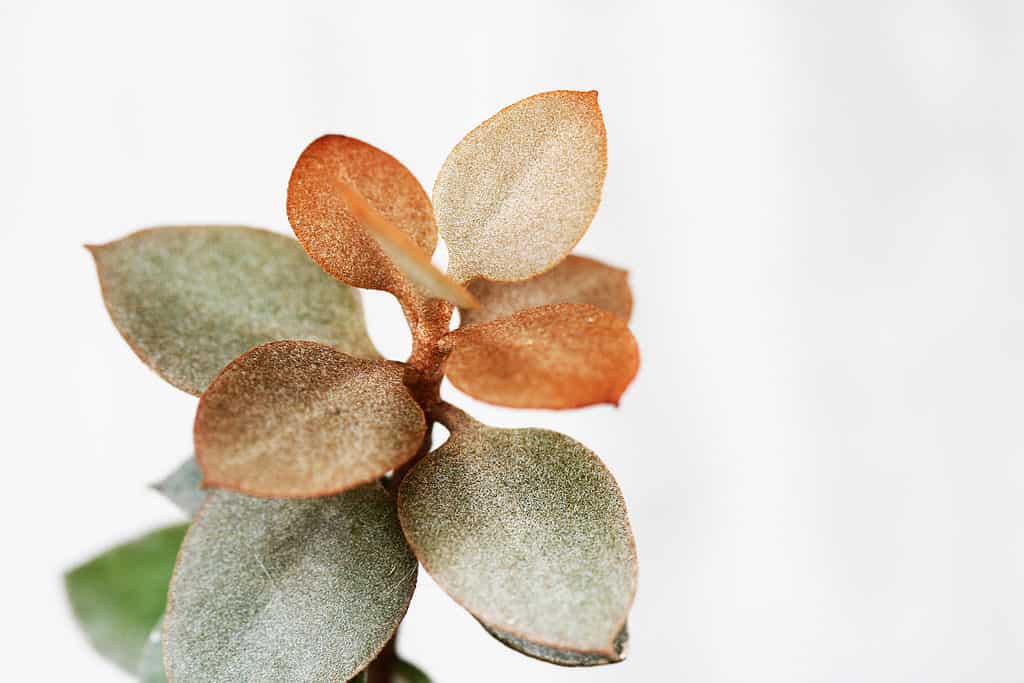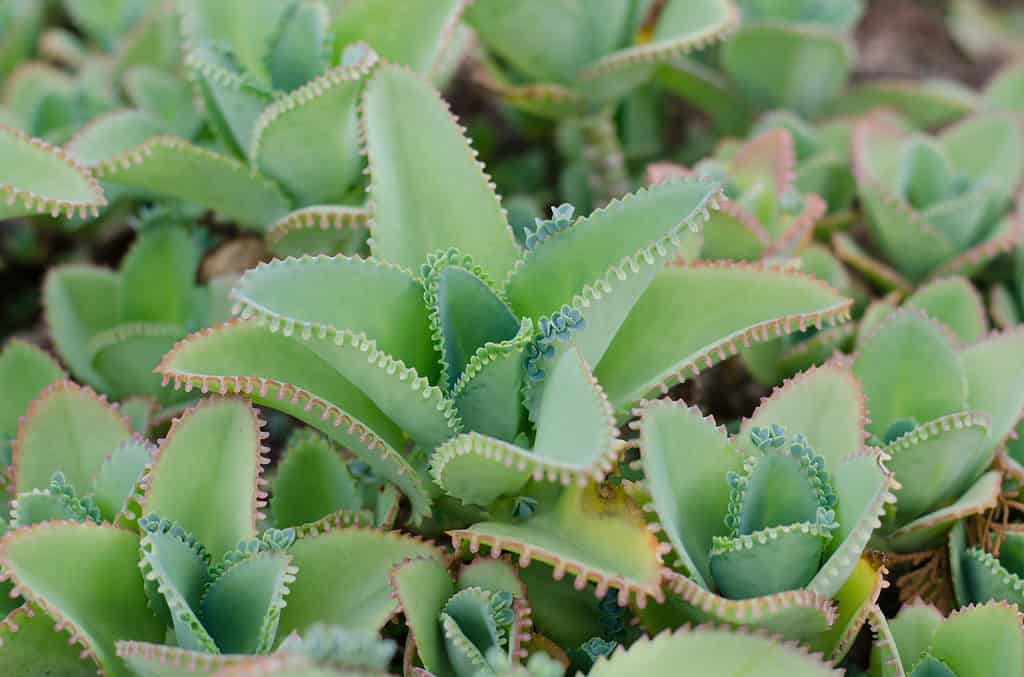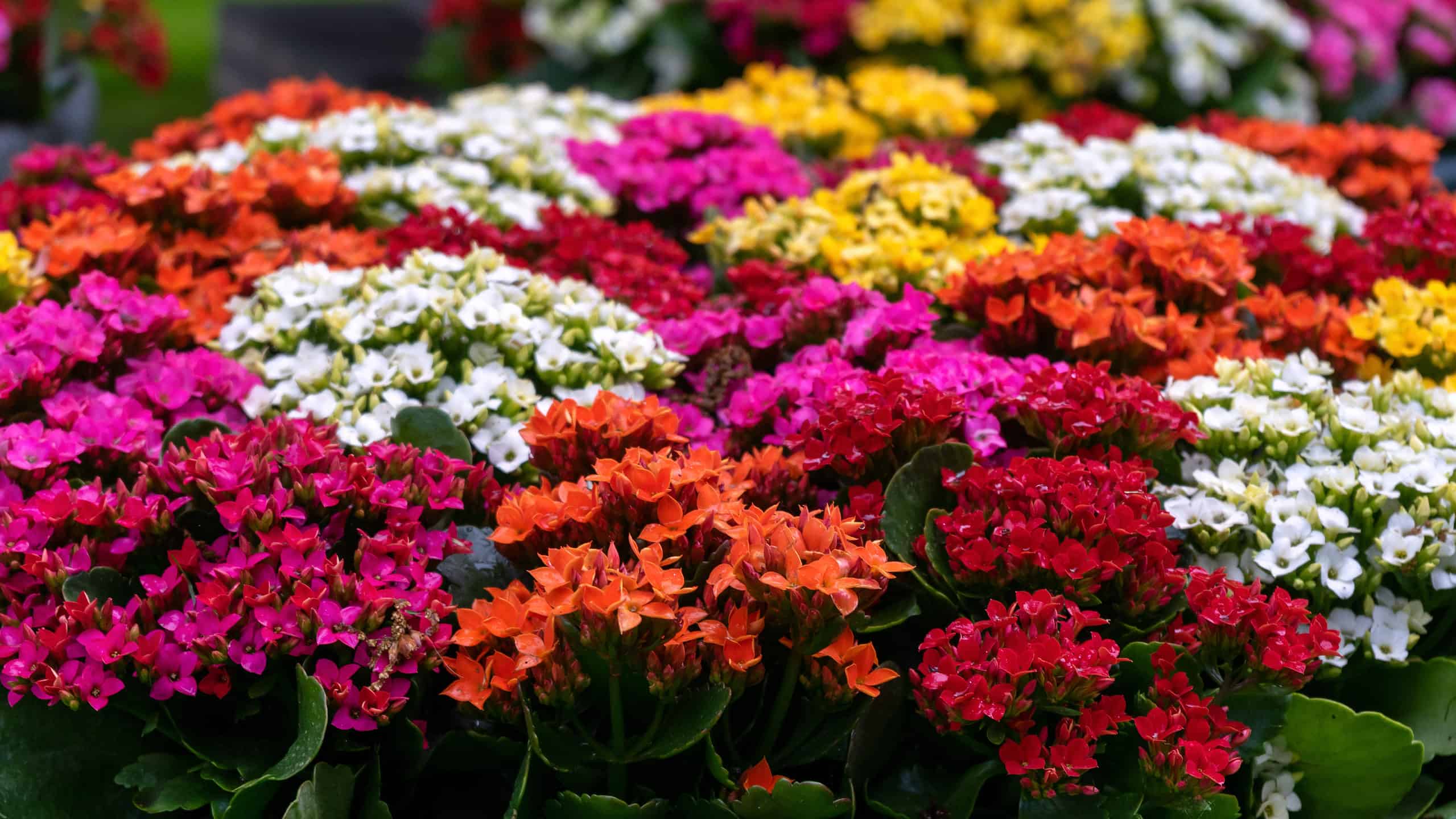Kalanchoes are quickly becoming a popular succulent option due to their versatility, beauty, and easy care requirements. A member of the family Crassulaceae with over 125 species, this succulent is related to Echeveria and Sedum and originates from Africa. Let’s explore ten of the best Kalanchoe varieties to grow at home.
1. Kalanchoe blossfeldiana
Sometimes called the “flaming Katy” or “widow’s thrill,” the Kalanchoe blossfeldiana is one of the most popular choices for indoor gardening enthusiasts.
This brightly-colored succulent has clusters of blooms in vibrant shades of yellow, orange, red, and pink. Supple green rosettes offset these blooms. The Kalanchoe blossfeldiana grows only about 12″ tall, making it ideal for indoor pots.
The Kalanchoe blossfeldiana requires bright, indirect sunlight to bloom. Plant in well-draining soil and allow it to dry completely between waterings. You can propagate your Kalanchoe blossfeldiana through stem cuttings.

The succulent
Kalanchoe blossfeldianahas clusters of blooms in vibrant shades of yellow, orange, red, and pink.
©iStock.com/Andrey Zhuravlev
2. Kalanchoe tomentosa
Also known as the “panda plant,” this succulent has fuzzy, silver-green leaves with brown-tinted tips that almost look slightly toasted. This succulent produces small pink flowers in the summer when cared for properly.
The Kalanchoe tomentosa has several cultivars, the most popular being Kalanchoe tomentosa ‘Chocolate Soldier.’
This easy-to-care-for plant thrives in bright, indirect sunlight and well-draining soil. Allow the soil to dry between waterings, and propagate in the spring with stem or leaf cuttings. When properly cared for, Kalanchoe tomentosa will grow up to 2 feet tall.

has fuzzy, silver-green leaves with brown-tinted tips that almost look slightly toasted.
©Shao-ping Huang/Shutterstock.com
3. Kalanchoe luciae
This unique Kalanchoe variety bears the nicknames “paddle plant” and “flapjacks.” This succulent has thick, paddle-shaped leaves that turn a vibrant red color when exposed to sunlight, and it produces small clusters of pink or yellow flowers in the spring.
These unique rosettes are similar to clamshells, growing low to the ground with the leaves reaching up to 2-5 inches wide. The plant itself grows up to 1-2 feet tall in ideal conditions.
This succulent loves the sun and prefers bright, direct sunlight. While it can grow in partial shade, it’s not ideal. Plant in well-draining soil and water infrequently. Propagate this beautiful plant with leaf cuttings.

Thick, paddle-shaped leaves that turn a vibrant red color when exposed to sunlight characterize
Kalanchoe luciae.
©iStock.com/svf74
4. Kalanchoe fedtschenkoi
Kalanchoe fedtschenkoi is a unique succulent with a cold-hardy nature and shrub-like appearance. Growing no more than 12″ tall, this succulent can survive as an outdoor plant in the Southern United States.
Also called “lavender scallops” or “South American air plant,” the Kalanchoe fedtschenkoi has thick, scalloped leaves. The leaves are bluish-green, and the plant blooms in pink or purple flowers with proper care. This variety prefers bright, direct sunlight, though it can grow in partial shade. Water infrequently, allowing the soil to dry completely. If you grow this succulent outdoors, consider covering it with burlap during the colder months. You can propagate Kalanchoe fedtschenkoi through stem or leaf cuttings.

The succulent
Kalanchoe fedtschenkoi, also known as lavender scallops, has bluish-green leaves and produces pink or purple flowers.
©Reallyice/Shutterstock.com
5. Kalanchoe humilis
This unique low-growing Kalanchoe has eye-catching green leaves with purple stripes. Reaching no more than a few inches tall, the Kalanchoe humilis blooms with ivory, white, or yellow flowers when properly cared for, adding a nice contrast to the foliage.
Unlike its African counterparts, Kalanchoe humilis grows in Northern Mexico and the Southern United States. While it’s more cold-hardy than other Kalanchoe varieties, it requires frost protection when grown outdoors.
Kalanchoe humilis prefers bright, indirect sunlight and infrequent watering. You can propagate this stunning plant with leaf cuttings.

As a low-growing succulent with eye-catching green leaves and purple stripes,
Kalanchoe humilisadds a touch of color to your collection.
©Pomme Home/Shutterstock.com
6. Kalanchoe thyrsiflora
This succulent is also known as “flapjacks” or “paddle plant.” Its appearance resembles Kalanchoe luciae, with a few key differences. Both have thick, paddle-shaped leaves that are blue-green in color and turn reddish-brown when exposed to sunlight.
However, Kalanchoe thyrsiflora has slightly smaller leaves, which only change color at the tips with a defined edge. On the other hand, Kalanchoe luciae leaves have more of a blush effect with an undefined border. Kalanchoe thyrsiflora blooms are also whiter and more fragrant than Kalanchoe luciae.
Kalanchoe thyrsiflora prefers bright, direct sunlight, though it should have some shade coverage during peak hours. This cold hardy succulent can be grown outdoors in temperate regions, though it requires frost protection. Water sparingly and propagate with stem or leaf cuttings.

is almost identical to
Kalanchoe luciae, but has slightly smaller leaves, which only change color at the tips.
©iStock.com/Denise Hasse
7. Kalanchoe delagoensis
Also known as the “chandelier plant” or “mother of millions (or thousands),” this succulent grows in stalks and produces small plantlets along the edges of its leaves. It was previously classified as Bryophyllum delagoense and looks quite different from other Kalanchoe varieties.
The Kalanchoe delagoensis has gray-green leaves and produces small, white, or pink flowers. With proper care, it can reach up to 6 feet tall. It reproduces quickly, producing small plantlets along the edges of its leaves, which eventually fall off and grow into new plants. The new plants continue the cycle, creating a rapid spread if left unchecked — no propagation is required.
Kalanchoe delagoensis prefers bright, indirect sunlight and may get scorched if exposed to direct light. Place in an outdoor area with partial shade or indoors set back from a sunny window.

produces small plantlets along the edges of its leaves which eventually fall off and grow into new plants.
©iStock.com/anutr tosirikul
8. Kalanchoe marnieriana
The Kalanchoe marnieriana is commonly known as the “mariner’s kalanchoe” due to its resemblance to a nautical rope. Its long, trailing stems and cascading foliage are also reminiscent of seaweed or other aquatic plants.
The Kalanchoe marnieriana has elongated, pointed leaves that are blue-green in color and often have reddish-purple edges. The leaves grow on upright stems that can reach up to 6 inches in height. The plant produces small, orange bell-shaped flowers in the summer for a blend of colors similar to a beautiful sunset.
This stunning succulent prefers well-draining soil, indirect sunlight, and infrequent watering. Unlike most Kalanchoe varieties, the Kalanchoe marnieriana prefers a relatively humid environment and thrives with regular misting. You can propagate the Kalanchoe marnieriana through stem cuttings.

produces small, orange bell-shaped flowers in the summer.
©COULANGES/Shutterstock.com
9. Kalanchoe orgyalis
People commonly know the succulent Kalanchoe orgyalis as the “copper spoons” or “leather plant.” Gardeners and plant enthusiasts often use these common names due to the plant’s distinctive look.
Thick, fuzzy leaves characterize the Kalanchoe orgyalis. They flaunt a copper color on their undersides and a velvety brown on top. These spoon-shaped leaves grow on upright stems that can stretch up to 3 feet tall. Although this succulent can produce small, brightly colored blooms, they only bloom for a brief period and often remain overlooked compared to the breathtaking foliage.
Kalanchoe orgyalis prefers bright, indirect sunlight with shade during peak hours. Use well-draining soil with more organic matter than typically used for succulent growth. Water infrequently, allowing the soil to dry completely. Propagate with stem or leaf cuttings.

The
Kalanchoe orgyalishas thick, fuzzy leaves that are copper-colored on the undersides and velvety brown on top.
©Pavaphon Supanantananont/Shutterstock.com
10. Kalanchoe pinnata
Also known as cathedral bells, life plant, or miracle plant, this succulent has long, narrow leaves that grow up to 6 inches in length. The Kalanchoe pinnata produces small, bell-shaped flowers in shades of pink or white.
The Kalanchoe pinnata gets the name life plant or miracle plant from its historical use in traditional medicine as an antihistamine, antimicrobial, and anti-inflammatory. However, scientists do not recommend eating this plant as it has potent qualities and should be processed and handled by a skilled professional.
The leafy nature of this plant makes it unique compared to other succulents. The frilly leaves and vibrant green tones make the Kalanchoe pinnata a wonderful addition to an indoor garden for those who like the low-maintenance nature of succulents but the leafy look of other plants.
Kalanchoe pinnata prefers bright, indirect sunlight and infrequent watering. You can propagate this succulent variety through stem cuttings only. While the Kalanchoe pinnata can grow up to 3 feet tall in its natural habitat, it tends to be much smaller when potted indoors.

has unique frilly leaves and vibrant green tones.
©iStock.com/joloei
Thank you for reading! Have some feedback for us? Contact the AZ Animals editorial team.








